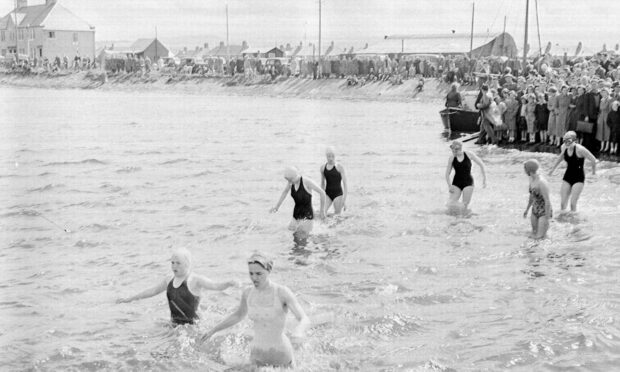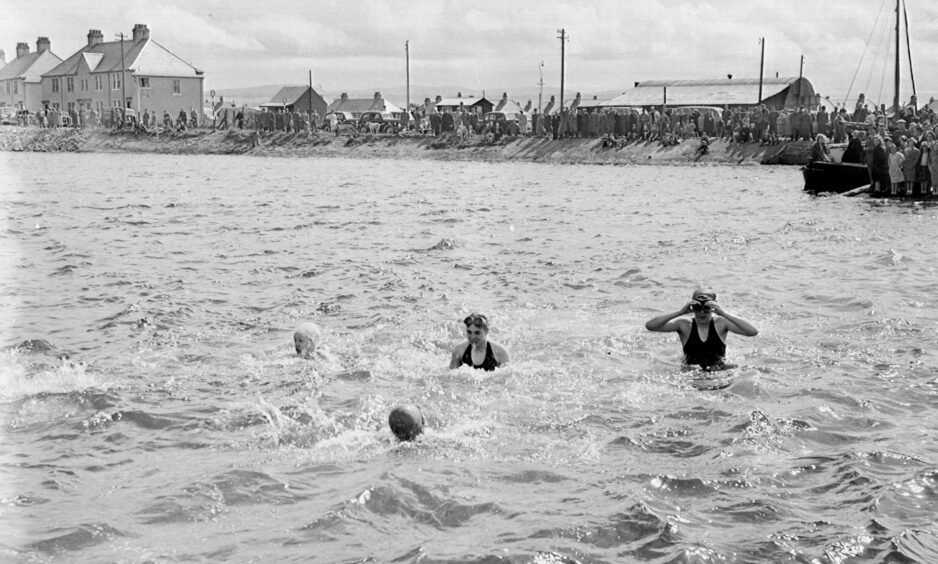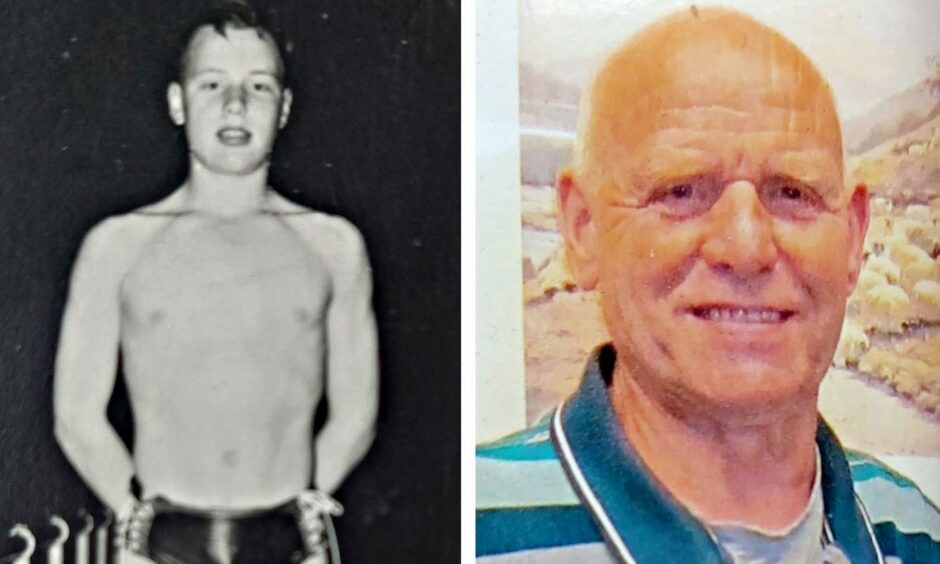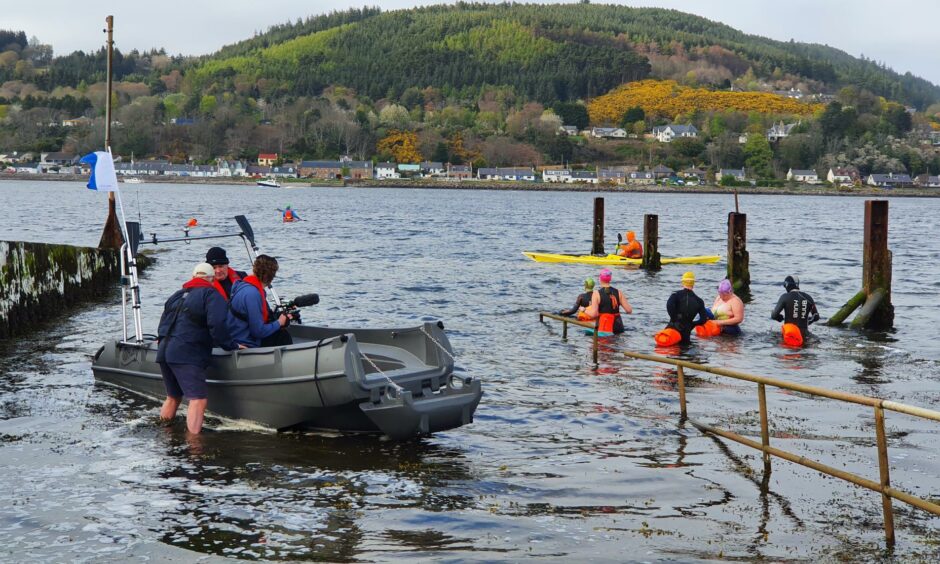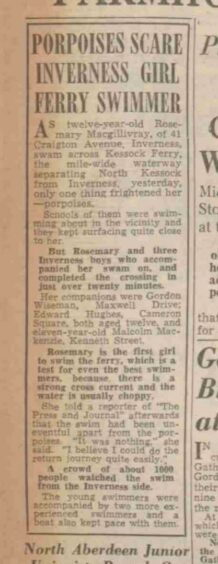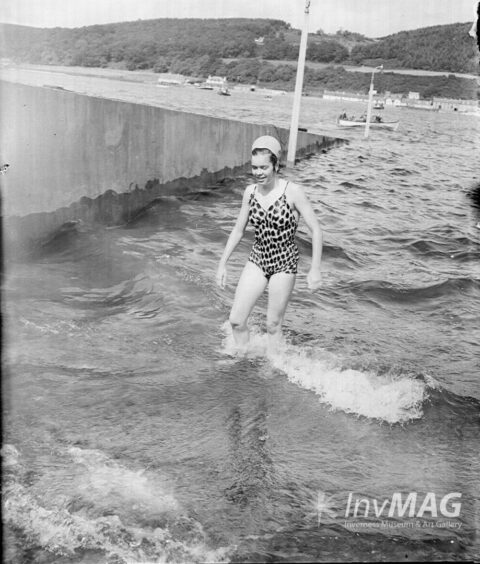Hugh MacLennan recalls vividly as a 12-year-old stripping down to just his trunks and plunging into the freezing water of the firth.
No wetsuit, just a nod to health and safety and a hot drink to recover from the cold, it seemed unremarkable to the young swimmer.
Open water swimming may have hit a wave of popularity at the moment, but it was a regular pastime for Hugh and his pals nearly 60 years ago.
Among his exploits was taking part annually in the Kessock crossing in the strait separating Inverness from the Black Isle.
The exposed stretch of tidal water between North and South Kessock and the Moray and Beauly firths was once the route of a small passenger and vehicle ferry.
It stopped in 1982 when the Kessock Bridge opened, taking the A9 north of Inverness.
The swim was not for the faint-hearted or casual swimmer and only a select few were deemed capable.
Children as young as eight took part in the swim
But in the 1940s, 50s and 60s, around 30 people, some as young as eight, made the crossing – and often the return – annually in an event that attracted crowds of around 1,000 people.
“You just arrived, got stripped down and off you went for a swim. You just got on with it,” said Hugh.
The Kessock Ferry Swim will return for the first time in more than 50 years on June 25 when around 250 swimmers from across the UK will take part.
Organised by South Kessock-based outdoor education charity Àban Outdoor Ltd, the response has been enthusiastic and it is hoped it will once again become an annual event.
It is thought the swim began in the late 1940s and ended in the late 1960s.
The Press and Journal reported in 1947 that a 12-year-old girl, Rosemary Macgillivray, completed the crossing in just over 20 minutes with three boys.
She was the first girl to achieve the feat and said afterwards it was uneventful apart from a school of porpoises surfacing near them.
In July 1950, the P&J recorded the achievement of Ian Black, who later competed in the Rome Olympics, as the youngest person to swim the Kessock crossing, aged just nine.
The following month, we reported that 12 members of the London Midland Scottish (LMS) amateur swimming club crossed the channel and back.
The swimmers braved intense cold, wind and rain, as well as 3-5ft high waves, with Maureen Alexander, 16, first to reach land.
‘We were always swimming’
Hugh, 78, now a semi-retired farmer in the Black Isle, took part in several swim crossings (1,200 metres there and back) until 1961.
A keen swimmer, he was a member of the LMS and also competed in the Scottish Schools Championships for three years.
He said: “In the good weather we were always swimming in the sea or the river.
“The first time I did the Kessock swim I was 12 and there were one or two younger than me.
“My father kept a couple of boats in the harbour and he ran one of the safety boats on the day.
“The first time I did it, I was quite happy to go just one way and my father was going to give me a lift back. But I felt pretty good and I decided to swim back too.
“I remember as I came up the pier a woman came out with a flask and gave me a hot drink of soup or tea.
“Some people just did one way and some of the younger ones, although they could swim, tried it but had to get hauled out after going so far.
“People took it quite seriously and the crowd that came to watch was incredible.”
He welcomes the fact the event is being revived and will go to watch: “It’s a great thing, but if there are so many doing it, it will need a fair bit of organisation.”
So many memories of the ferry swim
A number of others who took part in the swim will attend on the day.
Among them is Sandra Lea, 82, who participated in the event from the age of eight until she was 17 in 1957.
Johannes Petersen, the event organiser and founder of Àban, says the revival stems from conversations with local people.
“Lots of folks remember it and said their mother or their gran swam the crossing.
“It just felt like I’d taken the cork out of the bottle. There are so many memories and stories.
“The charity does most of its work there, it’s a lovely piece of local history and ties in with the current outdoor swimming boom. It just felt unstoppable really.”
Àban works with schools, community groups and other charities to offer low-cost, local outdoor adventures for children and families in need.
“It’s the sort of healthy outdoor playing that people used to do growing up that they can repeat in their own time.
“The swim is a perfect metaphor for that.”
The event is raising money for local charities including Friends of Merkinch Local Nature Reserve.
Those taking part this year are aged from 12 to late 70s and come from as far afield as the south of England.
Window of opportunity for event
With an expected water temperature of 11 degrees Celsius, all those under 18 are required to wear a wetsuit and all swimmers must use a high visibility tow float.
Four power boats and a fleet of sea kayaks are providing safety cover.
“Because the stretch of the firth is prone to strong currents, we’ve picked a window of opportunity on a weekend in summer and at high water with minimal tidal flow,” said Johannes.
“However, wind and heavy rain could prove problematic and we will have a contingency plan for extreme bad weather.”
As well as hoping to make it an annual event, he has commissioned a history of the historic swim.
“It is really striking now how young the children were who did that crossing.
“We decided the youngest should be 12, swimming with adults and they have to wear wet suits.
“So the idea of children as young as eight in there in just a pair of trunks is incredible.”
You might also like:
- Wild swimming: University to help create online advice on safety and suitable locations across Scotland
- Tidal pools across Scotland being revived as wild swimming trend surges in popularity
- I’m cured! Orkney man shakes off arthritis, diabetes and high blood pressure after taking up wild swimming challenge
